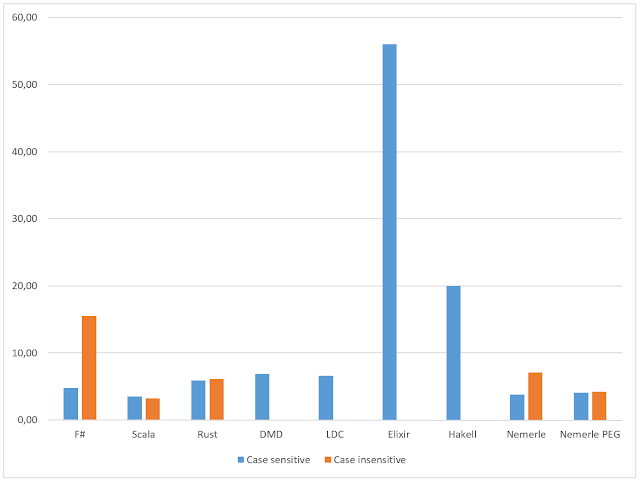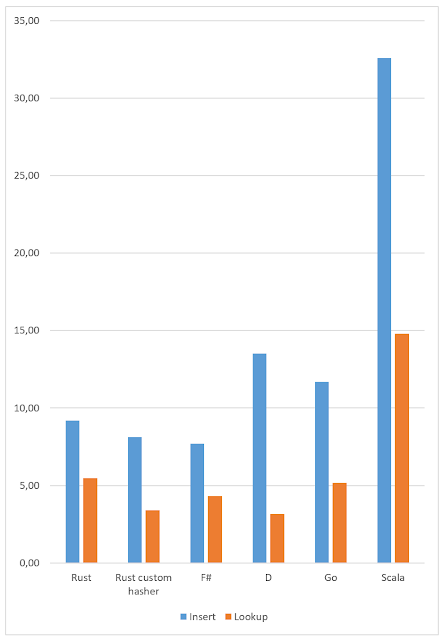Fibonacci: Hopac vs Async vs TPL Tasks on .NET and Mono
Hopac claims that its Jobs are much more lightweight that F# Asyncs. There are many benchmarks on Hopac github repository, but I wanted to make a simple and straightforward benchmark and what could be simpler that parallel Fibonacci algorithm? :) (actually there's a more comprehensive benchmark in the Hopac repository itself, see Fibonacci.fs)
Sequential Fibonacci function is usually defined as
So write a parallel version in Hopac where each step is performed in a Job and all these Jobs are (potentially) run in Parallel by Hopac's scheduler
An equivalent parallel algorithm written using F# Asyncs
...and using TPL Tasks
All three functions create *a lot* of parallel jobs/asyncs/tasks. For example, for calculating fib (34) they create ~14 million of jobs (this is why Fibonacci was chose for this test). To make them work efficiently we will use the sequential version of fib for small N, then switch to parallel version
Now we can run both of the function with different "level"s in order to find on which value the functions starts to perform good (x-axis: level, y-axis: time (ms), blue line: the sequential function, orange line: hopac/async/tasks function):
Hopac
Running on Mono (Ubuntu 14.10 x64, mono 3.10)
Hopac can handle ~6.8x more jobs than F# Async. I'm not sure if F# asyncs performs very well on Mono or it's because everything works extremely slowly there. What about TPL, it's obviously broken on Mono (official Hopac Fibonacci benchmark does not even run TPL version on mono: Fibonacci.fs#L233).
Sequential Fibonacci function is usually defined as
So write a parallel version in Hopac where each step is performed in a Job and all these Jobs are (potentially) run in Parallel by Hopac's scheduler
An equivalent parallel algorithm written using F# Asyncs
...and using TPL Tasks
All three functions create *a lot* of parallel jobs/asyncs/tasks. For example, for calculating fib (34) they create ~14 million of jobs (this is why Fibonacci was chose for this test). To make them work efficiently we will use the sequential version of fib for small N, then switch to parallel version
Now we can run both of the function with different "level"s in order to find on which value the functions starts to perform good (x-axis: level, y-axis: time (ms), blue line: the sequential function, orange line: hopac/async/tasks function):
Hopac
Async
Tasks
Hopac reaches performance equivalent to the sequential implementation at level = 9, Async - at level = 17 and Tasks at level = 11.
If we modify the code so we can count how many jobs/asyncs are created during the calculation
We get the following results (n = 42):
* Sequential, Real: 00:00:01.849, CPU: 00:00:01.840, GC gen0: 0, gen1: 0, gen2: 0
* Hopac (level = 9) jobs: 28761996, Real: 00:00:01.700, CPU: 00:00:05.600, GC gen0: 89, gen1: 1, gen2: 0
* Async (level = 17) asyncs: 605898, Real: 00:00:01.515, CPU: 00:00:04.804, GC gen0: 4, gen1: 2, gen2: 0
* Tasks (level = 11) tasks: 5675789, Real: 00:00:01.813, CPU: 00:00:06.302, GC gen0: 18, gen1: 0, gen2: 0
So, Hopac was able to create and processed ~47x more jobs than Async and ~5x more jobs than Tasks. Hopac is impressive and F# Asyncs are frustrating.
PS: Rewriting the async version without async computation explicit expression, like this
does not improve performance at all.
Running on Mono (Ubuntu 14.10 x64, mono 3.10)
* Sequential, Real: 00:00:02.637, CPU: 00:00:02.636, GC gen0: 0, gen1: 0
* Hopac (level = 17) jobs: 629133, Real: 00:00:02.447, CPU: 00:00:06.106, GC gen0: 26, gen1: 1
* Async (level = 21) asyncs: 92375, Real: 00:00:02.845, CPU: 00:00:05.590, GC gen0: 86, gen1: 3
* Tasks (level = 33) tasks: 143, Real: 00:00:14.111, CPU: 00:00:03.782, GC gen0: 0, gen1: 0
Hopac can handle ~6.8x more jobs than F# Async. I'm not sure if F# asyncs performs very well on Mono or it's because everything works extremely slowly there. What about TPL, it's obviously broken on Mono (official Hopac Fibonacci benchmark does not even run TPL version on mono: Fibonacci.fs#L233).
Update 10.09.2017 - use BenchmarkDotNet
n = 30, level = 15
Method | Mean | Error | StdDev |
------- |---------:|----------:|----------:|
Fib | 8.208 ms | 0.0432 ms | 0.0383 ms |
HFib | 1.860 ms | 0.0045 ms | 0.0042 ms |
AFib | 4.921 ms | 0.0330 ms | 0.0292 ms |
TFib | 2.229 ms | 0.0184 ms | 0.0172 ms |
n = 20, level = 0
Method | Mean | Error | StdDev |
------- |-------------:|-----------:|-------------:|
Fib | 68.21 us | 1.258 us | 1.177 us |
HFib | 356.21 us | 7.180 us | 11.595 us |
AFib | 31,815.44 us | 636.249 us | 1,524.413 us |
TFib | 1,623.25 us | 32.206 us | 33.073 us |






Comments
I prepared a complete file here:
https://github.com/vincenzoml/VoxLogicA/blob/gpu-new/testHopacVsTPL.fs